
by Deep Green Resistance News Service | Jun 2, 2018 | Strategy & Analysis
Editor’s note: The following is from the chapter “A Taxonomy of Action” of the book Deep Green Resistance: A Strategy to Save the Planet. This book is now available for free online.
by Aric McBay
All acts of omission require very large numbers of people to be permanently effective on a large scale. There are plenty of examples of strikes shutting down factories temporarily, but what if you don’t ever want that factory to run again? What if you work at a cruise missile factory or a factory that manufactures nuclear warheads? Is everyone working there willing to go on strike indefinitely? The large pool of unemployed or underpaid working poor means that there are always people willing to step in to work for a wage, even a relatively low one. Failing that, the company in question could just move the factory overseas, as so many have. All of this is especially true in a time when capitalism falters, and attempting to bring down civilization would definitely make capitalism falter.
The same problems apply to economic boycotts. You and I could stop buying anything produced by a given company. Or we could stop buying anything that had been sold through the global capitalist economy. We probably willsee widespread acts of economic omission, but only when large numbers of people get too poor to buy mass-produced consumer luxuries. But because of globalization and automation, these acts of omission will be less effective than they were in the past.
Which isn’t to say we shouldn’t undertake such acts when appropriate. Acts of omission are commonly part of resistance movements; they may be implicit rather than explicit. Pre-Civil War abolitionists would not have owned slaves. But this was an implicit result of their morality and political philosophy rather than a means of change. Few abolitionists would have suggested that by refraining from personally owning slaves they were posing a serious or fundamental threat to the institution of slavery.
An effective resistance movement based on acts of omission might need 10 percent, or 50 percent, or 90 percent of the population to win. One in a thousand people withdrawing from the global economy would have negligible impact. Acts of commission are a different story. What if one out of a thousand people joined a campaign of direct action to bring down civilization? Seven million brave and smart people could ensure the survival of our planet.

If we are going to talk about survival—or about courage, for that matter—we should talk about Sobibór. Sobibór was a Nazi concentration camp built in a remote part of Poland near the German border. Brought into operation in April 1943, Sobibór received regular train loads of prisoners, almost all Jewish. Like other Nazi concentration camps, Sobibór was also a work camp, both for prisoners skilled in certain trades and for unskilled labor, such as body removal. Sobibór was not the largest concentration camp, but it ran with murderous efficiency. Records show that by October 1944 a quarter of a million people had been murdered there, and some argue the casualties were significantly higher.26
Sobibór presented two distinct faces. Upon arrival to the camp, those selected to be killed received a polite welcoming speech from the Nazis (sometimes dressed in lab coats to project expertise and authority), and heard classical music played over loudspeakers. The door to the extermination “showers” was decorated with flowers and a Star of David. Touches like these encouraged them to go quietly and calmly to what some surely realized was their death. In contrast, those who were selected for work were shown a more overtly violent face, suffering arbitrary beatings and sometimes killed for even the smallest failure in cooperation. As at other concentration camps, if individual prisoners even attempted to escape, other prisoners would be killed as a reprisal. (At Auschwitz it was common practice for the SS to kill ten random prisoners for each escapee.)
Sobibór is a lesson for us because it became the site of the most successful—and also the most audacious—concentration camp uprising during the entire Holocaust. A small number of prisoners recognized that it was only a matter of time until they, too, were murdered, and decided that it was worth the risk to escape. However, they knew that those left behind would suffer the consequences of their act. So they hatched a bold plan to allow everyone in the camp to escape.
This was not an easy task. The camp was surrounded by multiple razor wire fences and a minefield, beyond which was forest. In addition to the SS, the camp had SS-trained guards of various Eastern European nationalities, guards who had themselves been brought in from POW camps. The perimeter of the camp had bright lighting systems and numerous machine gun towers.
A breakthrough came with the arrival of a group of Jewish-Russian POWs, with whom the long-time prisoners joined together and devised an escape plan. But to avoid being discovered, they had to keep the plan secret from all but a small group, meaning that the majority of the prisoners would be expected to escape at a moment’s notice without preparation. A Russian POW leader, Alexander “Sasha” Aronowicz Pechersky, understood the benefits. “As a military man, I was aware that a surprise attack is worth a division of solders. If we can maintain secrecy until the last minute of the outbreak, the revolt is 80 percent accomplished. The biggest danger was deconspiration.”27 In preparation for the escape, the conspirators used their trade skills to make or steal knives and axes small enough to conceal in their clothes.
At four o’clock on the day of the escape, they sprang into action. Carefully but quickly, they began to lure SS guards into private locations one by one, under various false pretexts. Then, small groups of prepared prisoners would quickly and quietly kill the SS men by striking them on the head with an axe, or by covering their mouths and stabbing them to death. Within an hour they had killed eleven SS men, half of the SS guards present at the time, and concealed the bodies. At five o’clock they came together for evening roll call, but they arrived slightly early, before the remaining SS men had gathered. Their plan was to avoid the minefield by simply marching as a group to the front gate, as though they were on their way to a work detail. Upon reaching the gate, they hoped to shoot the two Ukrainian guards present and then rush out the front way.
Though they had been lucky so far, one of the bodies was discovered at the last moment, before they could make for the front gate. The Russian Sasha made a very brief “every man for himself” speech and encouraged everyone to escape immediately. The camp then burst into chaos, with some proceeding to the front gate, and others breaking their way through the fence and taking their chances with the mine field. All had to deal with machine gun fire from the guard towers.
Of the roughly 550 prisoners, 150 were unwilling or unable to escape. Some were separated in a different subcamp and were out of communication, and others simply refused to run. Anyone unable or unwilling to fight or run was shot by the SS. About eighty of those who did run were killed by the mines or by hostile fire. Still, more than 300 people (mostly with no preparation) managed to escape the camp into the surrounding woodlands.
Tragically, close to half of these people were captured and executed over the following weeks because of a German dragnet. But since they would have been killed by the SS regardless, the escape was still a remarkable success. Better yet, within days of the uprising, humiliated SS boss Heinrich Himmler ordered the camp shut down, dismantled, and replanted with trees. (See, they don’t always rebuild.)28 And a number of the escapees joined friendly partisan groups in the area and continued to fight the Nazis (including Sasha, who later returned to the Red Army and was sent to a gulag by Stalin for “allowing” himself to be captured in the first place).
The survivors would spend decades mulling over the escape. In many ways, they could hardly have hoped for better luck. If their actions had been discovered any earlier, it’s very possible that everyone in the camp would have been executed. Furthermore, it’s simply amazing that half of the group—very few of whom had any weapons, survival, or escape and evasion training—managed to avoid capture by the Nazis.
They certainly would have benefitted from further training or preparation, although in this case that was at odds with their priority of security. Another issue identified by survivors was that almost all of the firearms went to the Russian POWs, meaning that most escapees were defenseless. They also lacked prearranged cells or affinity groups, and many people who did know each other became separated during the escape. A further problem was the fact that the prisoners did not have contact with Allies or resistance groups who could have helped to arrange further escape or provide supplies or weapons. In the end, a large number of escaped prisoners ended up being killed by anti-Semitic Polish nationals, including some Polish partisans.
Despite these issues, we can learn a lot from this story. The prisoners made remarkable use of their limited resources to escape. The very fact that they attempted escape is inspiring, especially when literally millions of others went to their deaths without fighting back. Indeed, considering that so many of them lacked specific combat and evasion skills and equipment, it was solely the courage to fight back that saved many lives.
No withdrawal or refusal would help them—their lives were won only by audacious acts of commission.
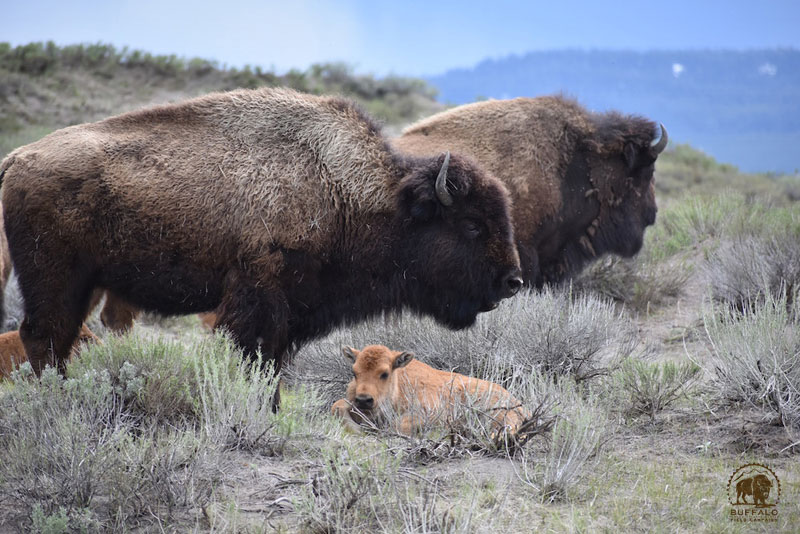
by Deep Green Resistance News Service | May 29, 2018 | Listening to the Land
by Stephany Seay / Buffalo Field Campaign
It’s been a pretty mellow week here with the buffalo. We’ve had very few instances of buffalo along the highway, but there is one big bull who is starting to stretch his legs into some of the newly gained year-round habitat. He has headed north of Fir Ridge, along Highway 191, moving out of the Hebgen Basin further north than we’ve seen a buffalo go in many years. He’s making us a bit nervous, though, as he’s in a tight, forested section and staying close to the road. If he continues north, the land will open up a bit, and if he continues even further north, he could potentially be the first buffalo to make it to the Taylor Fork in over two decades. There are some organizations and agencies who have wanted to capture and transport buffalo to the Taylor Fork, but we keep saying that if they want to be there, they will go. We’re keeping a close eye on this amazing boy who is showing other humans who want to “make” them do things that, if given time and space, they will be the ones to show us the way.
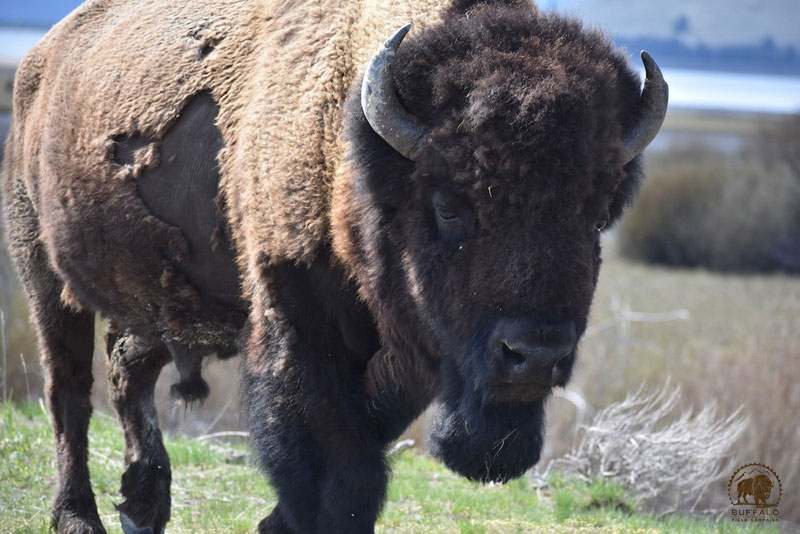
Around the Hebgen Basin, Central herd members continue to bring forth new life. Calving season got off to a bit of a late start, but, now, every day we are seeing more and more calves. Except for a few, short hazing operations and the challenges of the highway, the buffalo are at peace here. Moms can give birth without disturbance, and the calves are able to run, play, and grow strong without the threat of being hazed. While the Central Herd’s numbers are drastically down — our highest count here has been fewer than 250 in this Basin, and less than 100 counted on recons into Yellowstone’s interior — every single calf who is born is a symbol of resistance, an effort to make a comeback from Yellowstone’s senseless slaughter. Each calf is a celebration for the buffalos’ future. And, we want you to celebrate with us. So, instead of a lot of words, here is a little photo journey into wild buffalo calving season!
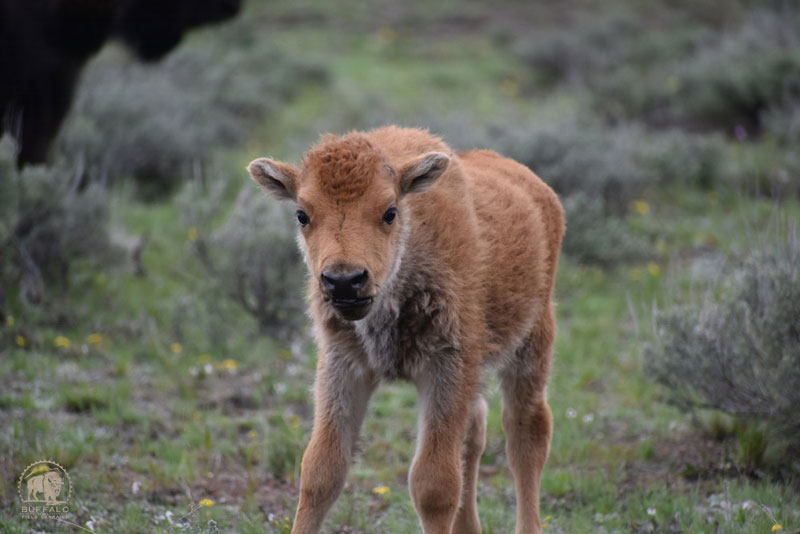
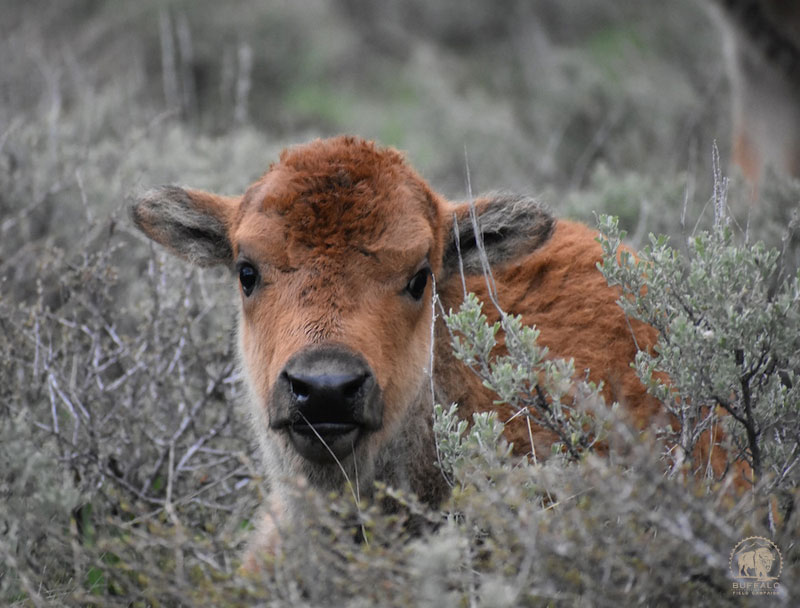
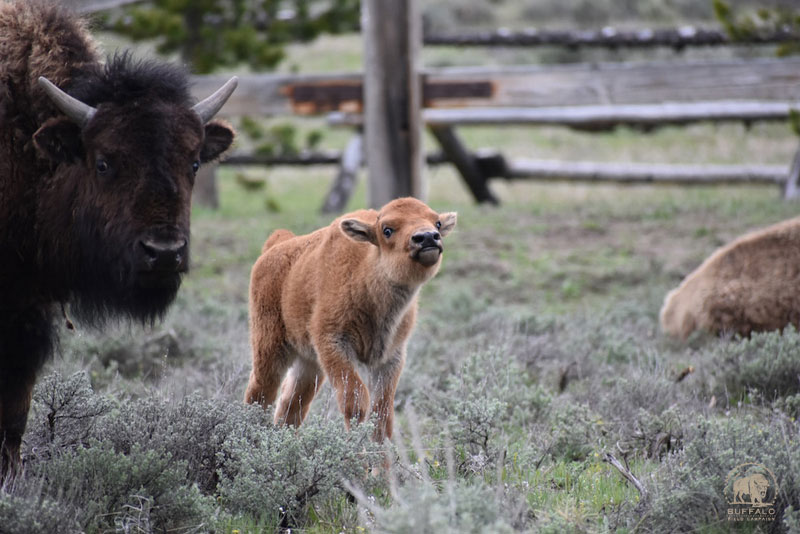
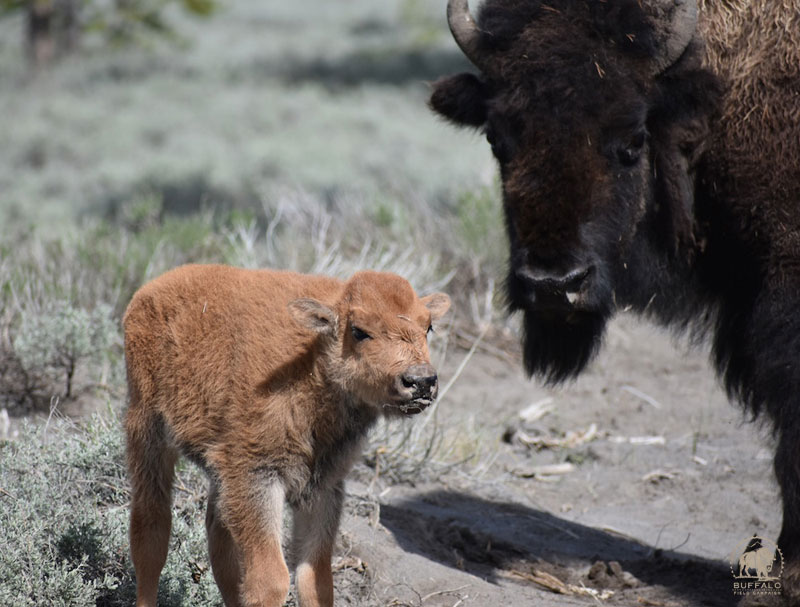
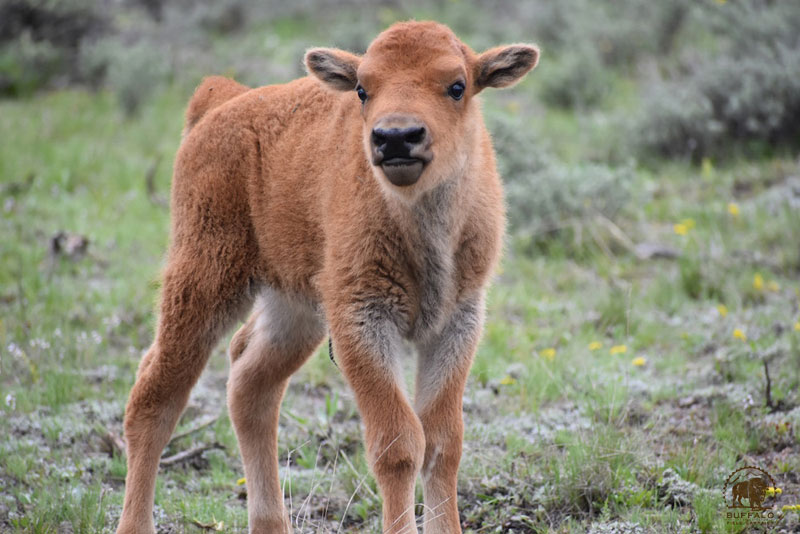
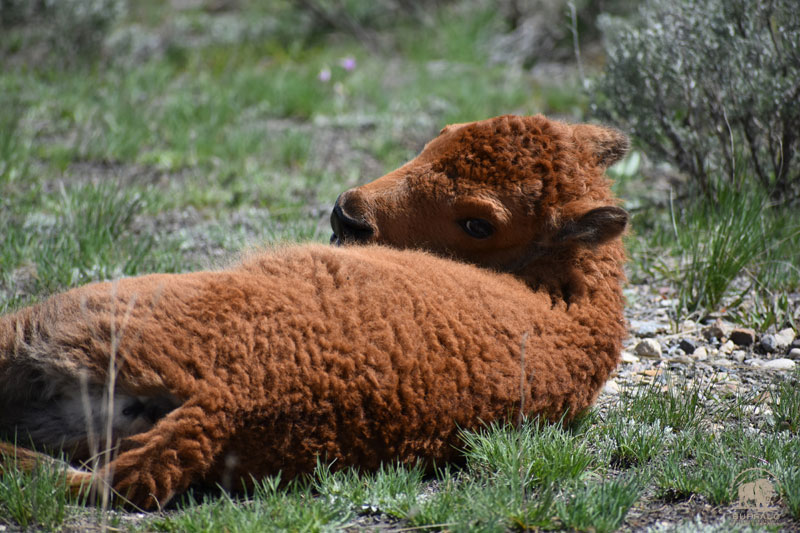
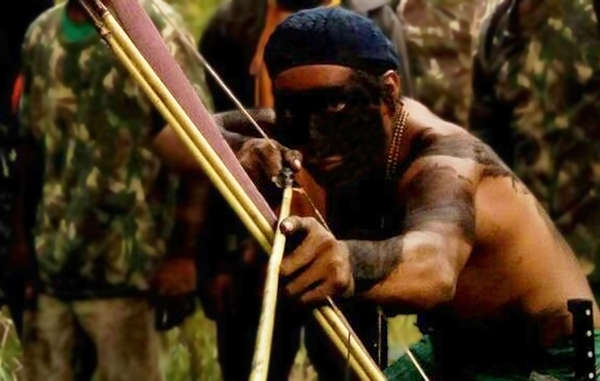
by Deep Green Resistance News Service | May 22, 2018 | Defensive Violence
Featured image: Guardians of the Amazon from the Guajajara tribe: “We patrol, we find the loggers, we destroy their equipment and we send them away. We’ve stopped many loggers. It’s working.” © Guardians of the Amazon
by Survival International
Members of an Amazon tribe patrolling their rainforest reserve to protect uncontacted relatives from illegal loggers have seized a notorious logging gang, burned their truck, and expelled them from the jungle.
The Guardians of the Amazon are from the Guajajara tribe: “We patrol, we find the loggers, we destroy their equipment and we send them away. We’ve stopped many loggers. It’s working.”
The area they are defending, Arariboia, is in the most threatened region in the entire Amazon. It is home to an uncontacted group of Awá Indians, a tribe well known for their affinity with animals and understanding of the forest, who face total annihilation if they come into contact with the loggers.
The Guardians have recently found abandoned Awá shelters close to where the loggers operate.
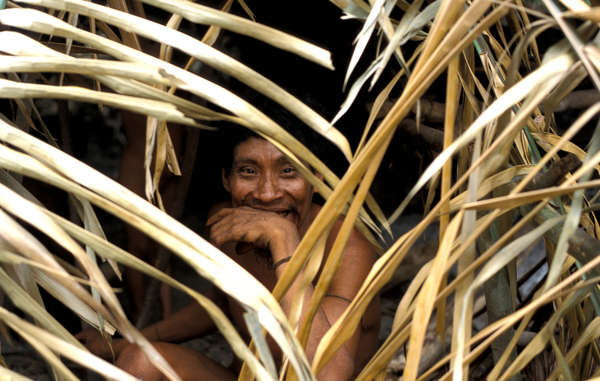
An Awá man called Takwarentxia, who was contacted in 1992 with his wife Hakõa’ĩ, and their baby. The rest of his family were killed by gunmen working for ranchers clearing the land. © Fiona Watson/Survival
They now fear violent retaliation. Three of the Guardians were murdered by loggers in 2016, and they have experienced arson attacks and regular death threats.
Burning Truck from Survival International on Vimeo.
The Guardians sent footage of the burning truck loaded with illegally cut timber to Survival International, along with the message: “Please show the world the reality we face. We know it’s risky and we have enemies but now’s no time for hiding. We want you to release this to the world so we can continue to protect our forest.”
Survival International has written urgently to the Brazilian government calling for the immediate and long term protection of both the Guardians themselves and of the area they fight to protect. Survival are also asking members of the public to send emails in support of the Guardians to government ministers via this page on their website.
Survival’s Director Stephen Corry said: “Tribal territories are the best barrier to deforestation, and these Guardians are defending the last patch of green amid a sea of destruction. It’s further proof that tribal peoples are the best conservationists and guardians of the natural world. The Guardians are virtually the only people standing between the loggers and the uncontacted Awá who still hold out in this forest. The Brazilian government’s inaction in the face of rampant illegal deforestation is shameful.”
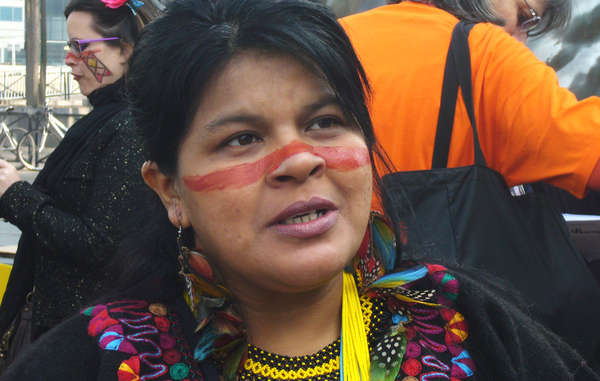
Sônia Guajajara at a protest in Paris against Brazil’s plans for a series of mega-dams in the Amazon, March 2014. © Survival International
She said today: “The Guardians’ work is both extremely valuable and incredibly risky. We indigenous peoples will never accept the ransacking of our Mother Earth – we listen to her and understand the way she talks to us because our life depends on her.”
BACKGROUND BRIEFING
The Guardians of the Amazon
– The “Guardians of the Amazon” are men from the Guajajara tribe in Brazil’s Maranhão state who have taken it upon themselves to protect what remains of this eastern edge of the Amazon rainforest.
– They want to save the land for the hundreds of Guajajara families who call it home, and their far less numerous neighbors: the uncontacted Awá Indians.
– The Guardians say of their work: “We patrol, we find the loggers, we destroy their equipment and we send them away. We’ve stopped many loggers. It’s working.”
– The Guardians recently released video and images of a rare encounter with the uncontacted Awá living in Arariboia. Watch the footage here
– You can see videos of several of the Guardians talking about their work on Survival’s Tribal Voice site.
Uncontacted tribes
– There are more than 100 uncontacted tribes worldwide. They have decided not to engage in regular contact with anyone from the outside world.
– They are not “lost” or trapped in a land that time forgot. They are aware of the outside world, and may engage sporadically with contacted tribes nearby.
– There’s irrefutable evidence that their tribal territories are the best barrier to deforestation, particularly in the Amazon rainforest.
– Uncontacted tribes are the most vulnerable peoples on the planet. Whole populations are wiped out by violence from outsiders who steal their land and resources, and by diseases like the flu and measles to which they have no resistance.
– It is not uncommon for 90% of the population to be wiped out following initial contact.
Awá
– The Awá are a hunter-gatherer people living in the forests of the eastern Brazilian Amazon
– While some Awá are in contact with the outside world, others are uncontacted.
– The Awá were known as “the most threatened tribe in the world” during a successful campaign by Survival International for the Brazilian government to expel the illegal loggers from one of their territories.
– The tribe are known for their affinity with the animals of their forest, and some families have more pets than people, from raccoon-like coatis to wild pigs and king vultures.
– Monkeys are the Awá’s favorites and individuals are often seen with their pet monkey riding on their head. Awá will rescue orphaned baby monkeys and adopt them as a member of the family, even breastfeeding them.
Arariboia
– The Arariboia indigenous territory comprises a unique biome in the transition area between the savannah and the Amazon rainforest.
– There are species here not found elsewhere in the Amazon.
– The land inside the indigenous territory is under threat from illegal loggers
– Brutal cuts in government funding to its indigenous affairs department FUNAI and tribal land protection mean the dangers are now even greater, as the area is not properly monitored or defended by the authorities.
– A powerful and violent logging mafia operates in the region, supported by some local politicians.

by Deep Green Resistance News Service | May 17, 2018 | Gender
For radical feminists, gender is understood as not merely a subjective internal sense of self; patriarchal gender norms are a product of culture, imposed on people and limiting everyone’s humanity.
by Robert Jensen / Feminist Current
I am routinely described as cisgender (defined as people whose internal sense of gender identity matches their biological sex). Because I have critiqued the ideology of the transgender movement, I also am often labeled a TERF (trans-exclusionary radical feminist). But neither term is accurate — I don’t self-identify as cisgender or as exclusionary.
Instead, I identify as an adult male who rejects the rigid, repressive, and reactionary gender norms of patriarchy, and I believe that radical feminism offers the most compelling analysis of a patriarchal sex/gender system. The feminist critique I embrace is not an attack on, nor an exclusion of, anyone who suffers from gender dysphoria or identifies as transgender, but rather offers an alternative framework for understanding patriarchy’s sex/gender system and challenging those patriarchal gender norms.
I used “patriarchy/patriarchal” four times in the last paragraph for emphasis: From a radical feminist perspective, nothing in sex/gender politics makes sense except in the light of patriarchy. (I borrow that formulation from the late evolutionary biologist Theodosius Dobzhansky, who said, “Nothing in biology makes sense except in the light of evolution.”)
“Patriarchy,” from Greek meaning “rule of the father,” can be narrowly understood as the organization of a human community (from a family to a larger society) that gives a male ruler dominance over other men, and overall gives men control over women. More generally, the term marks various systems of institutionalized male dominance.
In her 1986 book, The Creation of Patriarchy, the late historian Gerda Lerner defined patriarchy as “the manifestation and institutionalization of male dominance over women and children in the family and the extension of male dominance over women in the society in general.” Patriarchy implies, she continued, “that men hold power in all the important institutions of society and that women are deprived of access to such power. It does not imply that women are either totally powerless or totally deprived of rights, influence and resources.” The specific forms patriarchy takes differ depending on time and place, “but the essence remains: some men control property and hold power over other men and over most women; men or male-dominated institutions control the sexuality and reproduction of females; most of the powerful institutions in society are dominated by men.”
In today’s world, patriarchy comes in forms both deeply conservative (such as Saudi Arabia) and superficially liberal (the United States), and the laws and customs of patriarchal societies vary. But at the core of patriarchy is men’s claim to control — sometimes even to own—women’s reproductive power and sexuality. In patriarchy, men make claims on, and about, women’s bodies that are at the core of assigning women lesser value in society.
Radical feminists, therefore, focus on the fight for women’s reproductive rights, and against men’s violence and sexual exploitation of women. As feminists from various traditions have long argued, it’s crucial to distinguish between biological sex categories and cultural gender norms.
There are three categories of biological human sex: male, female, and intersex. The vast majority of humans are born with male or female reproductive systems, secondary sexual characteristics, and chromosomal structure, and there is a small segment (the size of this category would depend on what degree of ambiguity is used to mark the category) born with reproductive or sexual anatomy that doesn’t fit the definitions of female or male — anomalies of sex chromosomes, gonads, and/or anatomic sex. People born intersex, a biological reality, typically don’t identify as transgender.
Beyond “sex” is “gender” (the non-biological meaning societies create out of sex differences). Gender plays out in a variety of ways, including gender roles (assigning males and females to different social, political, or economic roles); gender norms (expecting males and females to comply with different norms of behavior and appearance); and gendered traits and virtues (assuming that males and females will be intellectually, emotionally, or morally different from each other).
In short: Sex is a question of biologically determined male and female, gender of socially determined masculinity and femininity.
The dominant conception of masculinity in U.S. culture asserts that men are naturally competitive and aggressive, and that being a “real man” means struggling for control, conquest, and domination. A man looks at the world, sees what he wants, and takes it. This is sometimes labeled “toxic masculinity,” which implies it is an aberration from some “normal” masculinity. But this understanding of masculinity-as-seeking-dominance is the default setting for most males growing up in patriarchy, especially through the glorification of aggression in the military, sports, and business.
All that definitional work is necessary to explain why I am not cisgender. As a male human, this patriarchal conception of masculinity is not my “chosen” identity, nor do I believe it is my fate. As a short, skinny, effeminate child — when I show people my church confirmation picture taken at age 14, they often assume it is a photo of a much younger girl — I never felt very masculine. As an adult with feminist politics, I reject and struggle to overcome the masculinity norms in patriarchy. If we were someday to transcend patriarchy, would I feel more “like a man”? That would depend on how the term was defined, but in the world in which I live, I refuse to embrace the patriarchal gender identity handed to me, a position I defend in a recent book, The End of Patriarchy: Radical Feminism for Men.
So, I’m not cisgender and I’m not transgender. I am not gender fluid, non-binary, or multi-gender. I self-identify as an adult biological XY male who rejects patriarchal gender norms and works from a radical feminist perspective to eliminate patriarchy, primarily through a critique of patriarchal norms in contemporary pornography.
For radical feminists, gender is understood as not merely a subjective internal sense of self; patriarchal gender norms are a product of culture, imposed on people and limiting everyone’s humanity. In such a political project, no one who wants to challenge patriarchy is excluded. Anyone who refuses to conform to patriarchal gender norms is welcome. Challenging patriarchy’s claims about how “normal” males and females should think/feel/act is encouraged.
But in such a project, it is necessary to name accurately the world and understand patriarchy. So, radical feminists continue to distinguish between biological sex and cultural gender, arguing that sex is a biological binary (we are a sexually dimorphic species) and gender is socially created hierarchy (in patriarchy).
There has been uncivil conduct on all sides of this debate, but it is only radical feminists who are routinely told that their position is hateful and that they should be excluded from the conversation. This has happened to me on occasion (including a speaking invitation rescinded after complaints to the event’s organizers, and protesters at another event attempting to shout me down), although radical feminist women are targeted much more intensely and often.
The most curious thing about my experience is that people rarely respond to the specifics of what I have written and instead simply denounce me, asserting that my arguments are outside the bounds of appropriate dialogue and need not be addressed. Often the denunciations imply that either I do not care about the very real concerns of transgender people regarding mental health, suicide, and violence, or that by making my arguments I actually am contributing to the violence against transgender people. I have been told that opponents of the transgender movement’s policy goals are simply bigots.
But there are important policy questions that are not resolved so simply, such as rules for participation in girls’ and women’s athletics; how to assign scholarships in women’s colleges; public financing for surgery that destroys healthy tissue; and the use of potentially dangerous hormone/drug therapies, especially for children. In Texas, where I live, the debate has focused on access to bathrooms and sex-segregated changing facilities, and the serious challenges raised by girls and women — concerns about privacy and how ambiguity in who has access increases the possibility of assault by non-transgender predators — have been dismissed as irrelevant.
As I always remind my students, reasonable people can and often do disagree, but reasonable conversation is difficult if we cannot agree on basic definitions of sex/gender and if those with a radical feminist analysis are labeled bigots and marginalized.
After four years of writing about this subject, I invite that conversation, and have been fortunate to have it with some in the transgender movement. But I challenge, firmly but politely, anyone who describes me as cisgender or calls me a TERF.
Robert Jensen is a professor in the School of Journalism at the University of Texas at Austin and the author of The End of Patriarchy: Radical Feminism for Men. He can be reached atrjensen@austin.utexas.edu.
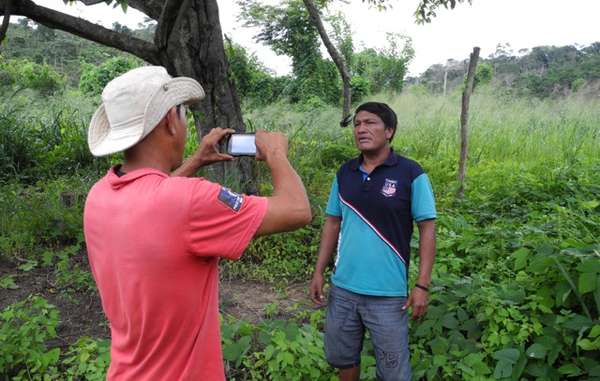
by Deep Green Resistance News Service | May 11, 2018 | Indigenous Autonomy
Featured image: With support from Survival, the Guajajara are able to expose illegal logging and threats to their uncontacted neighbors in real time. © Survival
by Sarah Shenker / Survival International
“We are here,” says Olimpio, looking directly into the camera, “… Monitoring the land and protecting the uncontacted Indians and the Guajajara who live here. Why? Because there are some people – anthropologists from some countries – who want, once again, to violate the rights of the uncontacted Indians in the country.”
Olimpio remains calm, but you can sense tension as he continues to speak.
“We are aware that some anthropologists have been calling for ‘controlled contact’ with the uncontacted Indians… We will not allow this to happen, because it would be another genocide.”
Olimpio is among the leaders of a group known as the “Guajajara Guardians,” men from the Guajajara tribe in Brazil’s Maranhão state who have taken it upon themselves to protect what remains of this north-eastern edge of the Amazon rainforest, the hundreds of Guajajara families who call it home, and their far less numerous neighbors: the Awá Indians, some of whom are uncontacted.
Uncontacted tribes are the most vulnerable peoples on the planet, and the Guajajara are acutely aware of this. Whole populations are being wiped out by violence from outsiders who steal their land and resources, and by diseases like flu and measles to which they have no resistance. The Guajajara know that the destruction of the forest, which the Awá have been dependent on and managed for generations, spells doom for the Awá and the Guajajara alike. All uncontacted peoples face catastrophe unless their land is protected. Without it, the Awá simply won’t survive.
The satellite imagery is startling: this territory, known as Arariboia, is an island of green amidst a sea of deforestation in this corner of the Amazon, which has been plundered for its iron ore; opened up by roads and rail; and chopped down for its valuable hardwoods.
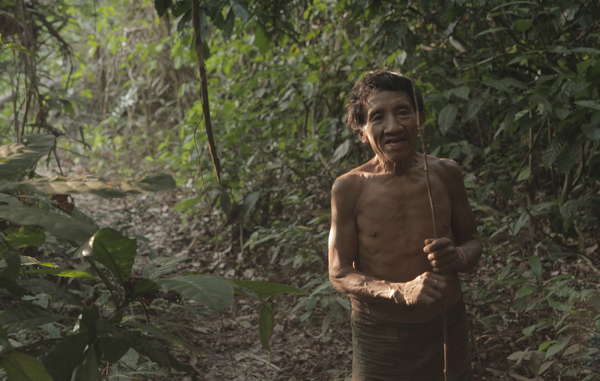
The Awá are one of the most vulnerable peoples on the planet. Some of them have no contact with mainstream Brazilian society, though the majority do. © Survival International
The uncontacted nomadic Awá live on a small hill in the centre of this island, where they hunt, fish, and collect fruits and berries. Its forest cover is thicker than that below. Following centuries of invasion, the Awá’s hill has become their refuge. They now number no more than several dozen.
As we looked up towards the uncontacted Arariboia Awá’s forest, it struck me that they really are living on the edge. Following centuries of land invasion and theft, and genocidal violence, they are clinging on against all odds. Preventing their annihilation is a matter of now or never.
I was here to learn about the Guajajara Guardians’ work and to set them up with communications technology as part of Survival International’s Tribal Voice project, which allows remote tribal peoples to send video messages around the globe in real time. It is one of the ways in which we work in partnership with them, and give them a platform to speak to the world. They were very enthusiastic about the possibilities this might offer, allowing them to expose logging and other attacks on Arariboia, and share information from their expeditions to protect their Awá neighbors.
First of all, however, Olimpio decided to record a denunciation of two American academics, Kim Hill and Robert Walker, rejecting outright their calls for forced contact with uncontacted tribes.
“It would be another genocide of a people, of indigenous people, who do not want contact, either with us, or with non-indigenous people” he says. It is hard not to be impressed by his determination.
*
Much of this region of Maranhão doesn’t really feel like the Amazon. The state borders the northeastern coast of Brazil and stretches downwards into the Amazon basin, but you don’t see the thick forests that people generally imagine when they picture the world’s largest rainforest. Instead, much of the area has been given over to agriculture in the form of ranches and plantations, or abandoned after the loggers have had their way with it and moved on.
After driving through countless miles of bleached brown grass, it is refreshing to reach Arariboia. The indigenous territory is home to the Guajajara and Awá peoples. Arariboia and other indigenous territories in the region are virtually the only remaining areas of genuine forest in the state. Crossing the border into indigenous land, things don’t feel all too different at first – in fact, vast swathes of forest in the territory were destroyed by fires last year, believed to have been started by the region’s powerful logging mafia. But the further into the area you head, the more you get the sense that you are in an island of lush greenery in the middle of the destruction so common elsewhere in this part of Brazil.
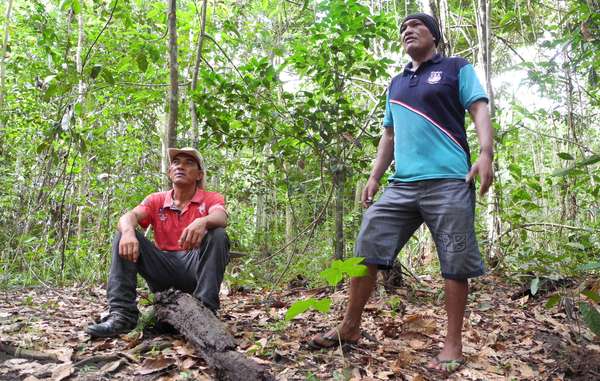
Olimpio and Franciel, coordinators of the Guajajara Guardians, are determined to protect the forest for their uncontacted Awá neighbors. © Survival
Although it is strictly forbidden under Brazilian law for outsiders to fell trees in indigenous territories, here and elsewhere in the Amazon loggers constantly flaunt this with impunity. Just on the drive up to Arariboia we passed dozens of loggers, their trucks piled high with illegally felled logs. I took a photo of one truck driven by two young men looking particularly pleased with their collection, and realized very quickly that they didn’t care. They do not attempt to hide their faces or their operations as they knew that the local government – largely controlled by the mafias who run this trade – will carry on turning a blind eye.
However, it is harder than ever for bandit loggers to operate in Arariboia. The Guardians, of whom there are around fifty, patrol the forest, monitoring, keeping their eyes open, and notifying the authorities. They do it in shifts, in their own time, with only sporadic financial and logistical support from the Brazilian government, despite its formal commitment to protecting the rainforest and indigenous rights. The work is time-consuming and far too much for a small band of committed volunteers. And it’s dangerous: In recent years, several Guajajara have been assassinated.
Why then, do they do it? I found it difficult to fathom at first. It is common for loggers to intimidate and murder indigenous people, so many feel forced into silent acceptance of the loggers and their activities. Sadly in this part of Brazil, many Guajajara also collaborate with the loggers, hoping to make some money from the trade, which they see as unstoppable. Alienated, threatened, and living on the fringes of a society that barely accepts them, the Guardians’ motivation for self-imposed vigilante duty is not outwardly obvious.
*
The more time I spent with the Guajajara in Arariboia, however, the more it seemed to make sense. Members of the tribe who live in the center of their land, closest to the Awá’s hill, are less integrated into mainstream Brazilian society, and feel a stronger sense of connection to their communal ways. They thrive in the forest, knowing it intimately and practising Guajajara rituals.
While I was there I witnessed one of these – a coming of age ceremony for a Guajajara girl. The tribe considers a girl’s first menstruation to be a hugely significant time, marking the passage into adulthood, and celebrate it as a community. The girl spent a week living in a small hut with a palm frond roof, attended by female relatives who would bring her food. Rather than being a solemn isolation, however, the rite of passage is a great celebration, and the Guajajara frequently burst into song and dance, paint their faces and revel in the girl’s new maturity. The men of the village, though not allowed to enter the hut, often come and stand close to the entrance and join in the singing.
Experiencing this put the Guardians’ desire to protect their forest and fellow indigenous people into context. To them, Arariboia is not a resource to be exploited in the name of “progress” and “civilization” – it is fundamental to who they are. They take great pride in it, protect what is left of it, and feel a deep sense of connection to it.
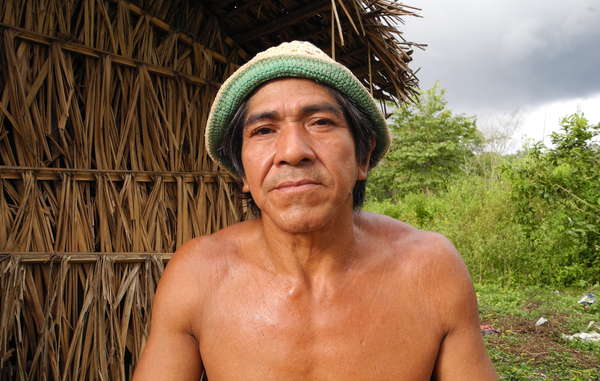
Survival has been working with the Guardians since 2015. © Survival
“People can’t take their land away from them,” another of the Guardians said to me, outraged, as we trekked through the forest close to one of the logging hotspots, “and they can’t take them away from their land.” He was indicating the Awá’s hill, which towers over the surrounding scrubland and lighter forest and provides a focal point in the landscape. The uncontacted Awá living there have expressed their desire to remain uncontacted, and the Guajajara want to see that desire respected.
Some see the centuries-long battle for survival between the indigenous peoples of the Amazon and the colonizers who exploit and destroy it as hopeless. Some, including the American anthropologists who the Guajajara were so keen to refute, see contact as inevitable and isolated uncontacted peoples as doomed. Deforestation will continue, they claim, and so tribal people will either have to assimilate with the Brazilian mainstream, or else face annihilation.
The Guajajara Guardians see it differently. They know what contact, “development,” and “progress” can mean for tribal peoples. They have watched as more and more of the forest that their ancestors were dependent on and managed for generations has been destroyed. And they’re keen to fight back, by boosting their land protection expeditions which are succeeding in keeping loggers out of some key areas, and by sharing their concerns with the world and encouraging international support.
For any tribal people, land is the key to survival. We’re doing everything we can to secure it for them, and to give them the chance to determine their own futures.
That’s also why Survival is giving the Guajajara, and other tribes, communications technology so they can speak to the world in real time. Their understanding of the problems they and their neighbors face is as astute as anyone’s and they have perceptive things to say about almost every aspect of life today. They are not only the best conservationists and guardians of the natural world, but are also at the forefront of the fight for human rights and self-determination. Maybe it’s time to listen.
Sarah Shenker was in conversation with Survival’s Lewis Evans
Act now to support the Guajajara Guardians


















